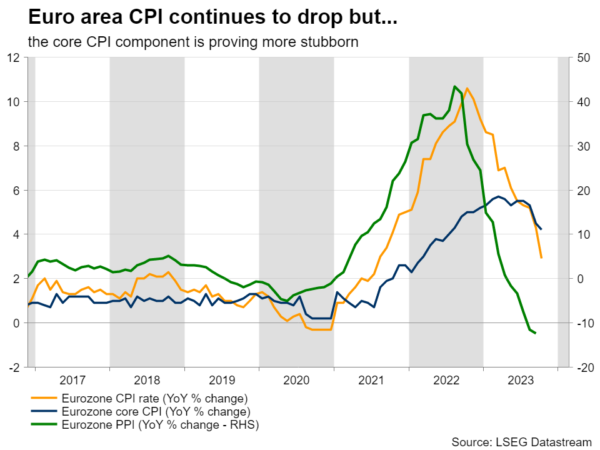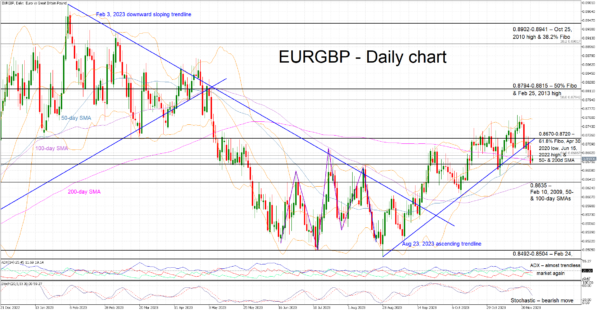- Key data releases on the menu as the ECB meets in two weeks
- ECB officials have been toning down their hawkish commentary
- The euro would welcome a strong inflation print and the ensuing hawkish rhetoric
- German CPI will be released on Wednesday; EZ aggregate on Thursday 10 GMT
Two weeks left for the last ECB meeting for 2023
With the Thanksgiving holiday break behind us, we are on the homestretch now for 2023. The market is counting down to the last round of central bank meetings starting with the RBNZ this week and concluding with the BoJ meeting on December 19. The ECB gathering is scheduled for December 14 and the market would be very interested in any rhetoric change by President Lagarde.
Ahead of this busy period, ECB members have been flooding the airwaves with their comments. They have been trying hard to convince the market that (1) rate hikes are not completely off the table, (2) rates will probably stay at the current levels for a while and it is too early to talk about rate cuts, (3) the current weak growth patch is expected to continue in 2024 but they do not expect a recession and (4) inflation is expected to edge a bit higher over the coming months.
At the end of the day though, their approach is data dependent. Since the October ECB meeting, euro area economic data prints have been mostly mixed. The weak preliminary GDP for the third quarter of 2023 has been followed by subdued retail sales, revealing the impact of a rather long period of continued price increases. Inflationary pressures have been abating but core inflation remains stubbornly high, complicating the outlook. At least, PMI surveys have been picking up pace, although the German PMI manufacturing survey is stuck at an extremely low level.
November inflation report in focus
Τhis week we will get the preliminary inflation report for November. On Wednesday, the various German states will publish their figures with the German national figures expected after 13.00 GMT. The annual German inflation figure has been on an aggressive downward trend since the November 2022 peak of 8.8% with forecasts revolving around another deceleration to 3.5%.
The euro area aggregate print is expected on Thursday. With the headline indicator gravely affected by the weaker energy prices and thus seen recording a 2.8% YoY change, the core indicator is bound to get more attention. The core index, excluding energy, food, alcohol and tobacco, has been falling from the March 2023 peak of 5.7% and it is forecast to fall below the 4% level for the first time since July 2022.
However, it remains at an elevated level, and above the headline figure. ECB members are worried that the supply issues and stronger wage increases across the euro area are potentially supporting the stickiness of core inflation.
With the market fixated with rate cuts – the first 25bps rate cut is fully priced in by June 2024 – a possibly strong inflation report is unlikely to affect market expectations. In fact, only a combination of stronger growth indicators such the PMI surveys and repeatedly stronger inflation prints could convince the market that rate cuts are probably not around the corner at this stage.
Euro in danger of losing its recent hard-earned gains
The euro has been outperforming the pound since late August, but these hard-earned gains could be under threat now. Last week’s UK Autumn Statement appears to have invigorated the pound bulls but the next leg in the euro-pound pair will probably depend on this week’s data calendar, and predominantly the November inflation report.
A strong set of data this week could help the euro-pound pair climb above the August 23 ascending trendline and potentially open the door for a move towards the 0.8794-0.8815 area. On the flip side, weak data results and dovish rhetoric from ECB officials could mean the current correction might have legs, with 0.8635 being the next credible target.















